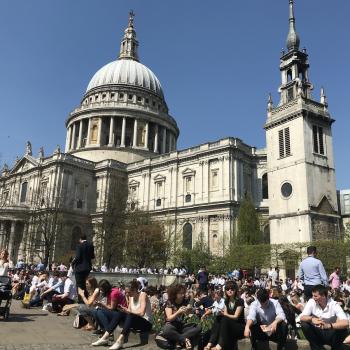This morning I attended one of the training tracks where my friend Steve Tibbert was speaking. Steve has recently written a book, Good to Grow about what God has done in King’s Church Catford.
He explained that in his view how we build structures and programs around the gospel is critical. Structures themselves will not bring growth and breakthrough. It is God that brings life. God is the only person who can save someone. You will get ideas here, but do not over-egg our own importance or the way we build. Paul says,
I planted, Apollos watered, but God gave the growth. So neither he who plants nor he who waters is anything, but only God who gives the growth. (1 Co 3:6–7).
We do need both wine and wineskins. We don’t want the wine to run away. We need a flexible wineskin that stretches to accommodate it. We need a skeleton and we need flesh. We need the presence of the Spirit but we need proper structures to contain the growth.
The wrong structure can hinder growth. Acts 6 shows us huge growth and people start to be overlooked. The Apostles redefine their job description and delegate away. The summary of the results of the adjustment is that the word of God spread. The widows were cared for, but the gospel went forth. Sometimes churches stop growing because they hit a barrier and are unwilling to adjust the way the live out their values.
Principles he has learned
1. Church size changes everything Tim Keller has written on this, “the difference between a church of say 100 and 1000 is far greater than the difference between different movements that hold different theological positions.” Steve always asks people if they have come from a smaller or bigger church than Kings.
We must learn to lead the church in a way that is relevant to the size you are and the size you are becoming. How you lead at 40 is different at 200, then different again at 500 and 800. Have to track and care for people. Cant pastor 300-400 new people by osmosis.
2. Philosophy of ministry is really important. More conflict happens over this than anything else. It is the priority you put one value over the other and how you work any value out in practice. So for example, we all want to share Jesus but the way you do that is very different in different places. Alpha is more about taking people on a journey, meet them where they are. Steve lets people come as quickly or slowly as they like. Effects every aspect of church life. It is often unsaid but it is there. Which value you put priority on is critical. Steve says “We are a missional community first, mission trumps everything.” Sometimes people say we must stop on the mission for a while and fill people in. Steve says, “No! We are a missional people first.” Obviously does fill in behind but not at the expense of mission. The church you are a part of will usually reflect the primary gifts of the lead elder. So for Steve he is a leader first, with an evangelistic heart. You can tend to look at church through those eyes. Most of our churches are led by pastor-teachers. Steve has been keen to over-egg mission to keep balance as most people have a pastoral emphasis. You need a strategy of how to implement it.
Rick Warren speaks of how you need to work on the community, crowd, congregation, committed, and the core. Many churches focus only on members and unbelievers. We have a group of people who are on a different phase of their journey. So for example at Christmas they wont to focus their whole service on the community and crowd. Know where on the spectrum you are trying to serve the people.
3. At Kings their primary growth engine is Sunday. The larger they get the more that is true. They run Alpha, but Steve believes that in the UK nothing is more effective than Sundays. Steve has a “high Sunday” strategy. Simple idea, which is that you have focused Sundays when people are going to invite as many people as possible and going to have the best foot forward. We are looking for God to meet with them. Then we provide a next step. They need to encounter God. Don’t just take the strategy and forget the life! There needs to be preaching that is clearly gifted.
Visited integration team at Willow Creek, learnt the following. Most churches get new people most weeks. Lets say you have one a week. How a person joins a church is a big deal for that person. How you care for the new person makes a massive difference on whether they stay or not. If a new person comes, on average 1 in 4 will join. So if you have 100 people, you may have 60 new people, 15 join but what happens if 15 leave you haven’t grown. If you simply make connection with a phone call within 48 hours your retention can go up to 1 in 2. Then suddenly you have grown.
Leading indicators on what is happening. Predicts from the number of new people forms how many will join, and predicts pressure on the church buildings, and the financial projections. Steve projects forward on pervious trends 5-10 years.
4. There is a relationship between team, building and money. At around 200 you face a facilities challenge. It is a scale issue. The leadership strengths that have got the church to 200 can become the limits that stop it moving on. Most churches never get over this. The leader has to learn to work through other people. We must be aware of our measure in God. The question is what you are called to do. Leadership and building problems collide when you need to raise lots of money to employ new team members and buy a building. Many leaders are unable to make that transition. At around 800 it happens again, with more zeros on the end! You have to adjust again at that point.
Brief notes from the Q and A
Wrong kind of structures that hinder growth: How the team works. Have to work differently. The team members who like being generalists, but in bigger team you need to specialize. Being focused down can be hard. You can have projects that may have a high profile in a church but actually not be fruitful, and so it may even need to be killed because it is draining resources. Or you can put the profile on other things that are more fruitful. Teaching, vision, example are all important. Have a long term aim, but don’t tie it to time. Re-engineering. Very focused on the new people. Took 10 years to get from 200 to 500. “Overnight success takes 20 years.” However very rare for a team to stay static for 15 years. So there will be some movement in the team, and that can lead to planting churches. As you develop as a church, you can develop leaders and then plant out with some of them. 2-500 are a mixture of specialists and generalists. Around 800 you have to go departmental as each area is so large. Must become leaders of leaders.
They use a volunteer to call the person.











